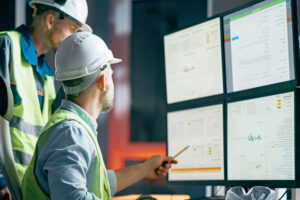The measured values from the decentralized edge devices must be made available to the user on a central cloud platform.platform must be made available to the user. From Microsoft Azure and Amazon AWS to process control systems, there are many existing cloud solutions depending on the use case, in which the data is required.
Billions of small and inexpensive edge devices have the specific task of measure values and transmit them to the cloud. These devices are often limited in terms of their computing capacity and storage space. It is only in the cloud that historical data is analyzed and complex computing operations are carried out. Here , data from a wide variety of sensors and information information systems are combined to create a complete picture.
Challenges of the cloud
But the cloud is reaching its limits. Data from billions of devices is constantly flowing into the cloud, resulting in a considerable load. With many cloud platforms running critical business applications, it is important to ensure that they are constantly available and that there are no latencies. Many cloud platforms simply cannot copewith the massive onslaught of data.
The “Fog” as a solution
And so a fog is rising between the edge devices and the cloud: an intermediate layer known as fog. Fog computing refers to a decentralized network in which the data from the quadrillions of edge devices isdevices are collected close to the data source, pre-processed and stored. The fog nodes therefore relieve the cloud enormously and help to avoid potential bandwidth bottlenecks.
An intermediate layer known as “fog” is formed between the edge devices and the cloud. Fog computing describes a decentralized network, in which the data from the edge devices is collected, pre-processed and stored close to the data source. The fog nodes significantly reduce the load on the cloud and help to avoid potential bandwidth bottlenecks.
Tasks of the fog nodes
The fog nodes perform defined tasks independently. This means that not all data has to be sent to the cloud, and the cloud does not have to be consulted for every little decision. A classic task for the fog nodes is device management. This generates a lot of data, such as reception quality, batterycharge status and health data from the edge devices. This operating data is relevant for a functioning system, but not necessarily for the customer’ s application, which only requires the actual measurement data in its cloud.

Efficient distribution of the workload
The division between Edge, Fog and Cloud ensures a targeted distribution of the workload. For a robust software landscape, it is crucial that an intermediary acts like the Microtronics platform. It ensures that requests, updates and data transfers from many hundreds or thousands of sensors are managed efficiently. According to the edge fog cloud architecture, resources are distributed sensibly and efficiently. Each system does what it does best.
Over-the-Air-Updates and NIS-2
The NIS 2 Directive regulates the cyber and information security of companies and institutions and must be implemented by October 2024. This directive stipulates that devices can be updated over-the-air (OTA). This update function of a distributed network is a reinsurance for unforeseeable problem cases and enables significantly greater flexibility and speed in product development. The fog nodes manage this central task of OTA updates for the many billions of edge devices. The business-critical cloud system is thus freed from an enormous workload.
The combination of Edge, Fog and Cloud ensures that the workload is optimally distributed and that each system can fully exploit its strengths. The Microtronics platform plays a central role in this by managing effective device management with OTA updates, thus ensuring part of the implementation of security guidelines such as the NIS-2 directive.


